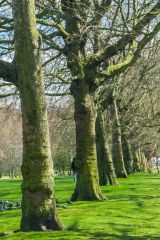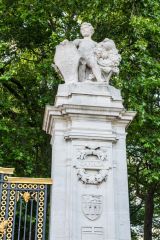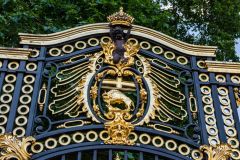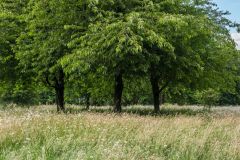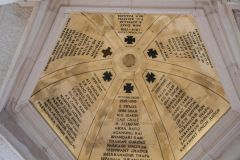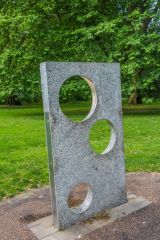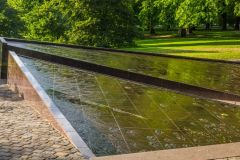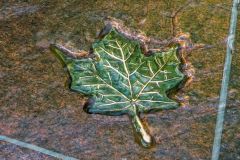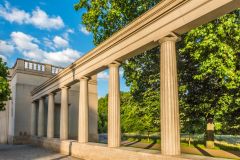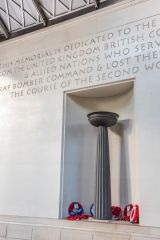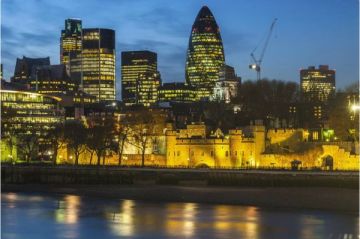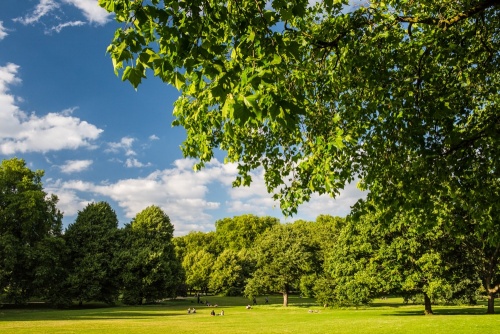
Stretching north and west from Buckingham Palace is Green Park (or, more correctly 'The Green Park'), a triangular public park linking the palace to Picadilly and Hyde Park Corner. Green Park is one of eight royal parks in London (the others being Richmond Park, Bushy Park, Hyde Park, Kensington Gardens, Greenwich Park, Regents Park and neighbouring St James Park).
Green Park is the setting for Royal Gun Salutes, marking special royal occasions such as state visits, the monarch's official Birthday, Accession Day, The Prince of Wales' Birthday, and the State Opening of Parliament. Salutes are usually fired at noon and consist of 41 rounds (the traditional 21 rounds plus an extra 20 because Green Park is a royal park).
Green Park covers just over 30 acres (12 ha) but has no formal flower beds. Why? Because, according to tradition, King Charles II's wife Queen Catherine of Braganza had them all removed when she found the king picking flowers there for a milkmaid that he had his eye on. So it became literally 'the green park', with no flowers.
There may be no flower beds but there are a million daffodils planted throughout the park, making it a sea of gorgeous yellow colour in spring.
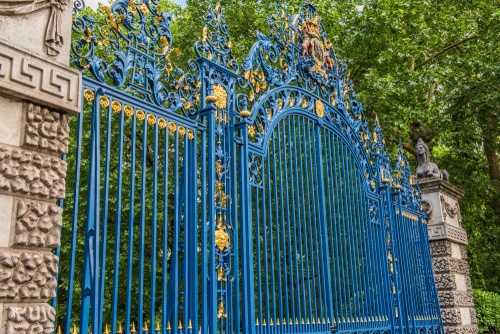
History
The first written record of Green Park comes from 1554 when Sir Thomas Wyatt launched a brief and unsuccessful rebellion there to protest against the marriage of Mary I to Philip of Spain. He paid with his life. At that time the park was simply open meadows, used for hunting - and duelling.
King Charles II wanted to be able to walk from St James Park to Hyde Park so he bought the land linking the two existing royal parks. Charles then enclosed the meadows in 1668 to create a royal deer park for hunting, with a live-in ranger to manage the deer herd.
He also built an icehouse - one of the first in Britain - where ice could be stored to keep drinks cool when the king was entertaining guests in summer. The king was fond of a daily walk through the park, or 'constitutional', which explains how Constitution Hill, along the southern boundary of the park, got its name.
The hunting ground was known as Upper St James Park until the middle of the 18th century but the name 'The Green Park' made official in 1746. In 1749 a temporary Temple of Peace was erected to commemorate the end of the War of Austrian Succession.
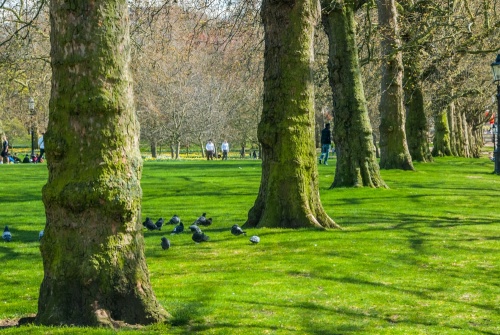
The royal family planned a huge celebration and commissioned the composer George Frederick Handel to write his 'Music for the Royal Fireworks' especially for the event. Fireworks were stored in the Temple of Peace, but in a tragic turn, a stray rocket hit the Temple, igniting 10,000 fireworks, which exploded, destroying the building and killing three people.
In 1814 a Temple of Concord was built to mark the centenary of Hanoverian rule. Like the Temple of Peace before it, the temple burned down during the celebration.
By that time Green Park had evolved to become a pleasure garden rather than a hunting ground; Tyburn Pool was created in the centre of the park in the early 18th century and in the 1720s Queen Caroline, wife of George I, had a reservoir created to supply water to Buckingham House (now Buckingham Palace) and St James Palace. The reservoir was, not surprisingly, called Queen's Basin. She also built a library, called ... yes, Queen's Library.
Beside the reservoir ran Queen's Walk, a promenade laid out in 1730. This quickly became a fashionable place for high society to 'see and be seen'. Green Park was such a popular place that it led many of London's wealthiest residents to build expensive mansions along nearby Piccadilly.
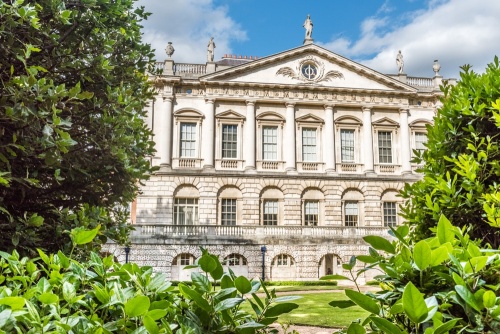
In the 1820s the Regency architect John Nash planted trees in the park as part of his scheme to improve St James Park, of which Green Park was still considered a part. He also straightened Constitution Hill to make a processional route linking Hyde Park Corner with The Mall.
At the Hyde Park Corner end of the route the Wellington Arch was erected to mark the place where Green Park ends and Hyde Park begins. The arch originally served as the northern gateway to Buckingham Palace but was moved to its present location in 1882.
It was not until 1826 that Green Park opened to the general public. Within a few decades the structures within the park (Tyburn Pool, Queen's Basin, and the Ranger's Lodge) had all been torn down.
What to See
Bomber Command Memorial
By far the most impressive monument in Green Park is the Bomber Command Memorial on Piccadilly, facing the Wellington Arch. This imposing neoclassical memorial honours the 55,573 service personnel who died whilst serving with the Bomber Command during WWII. The memorial was designed by Liam O'Connor and is built of cream-coloured Portland stone. At the centre of the memorial is a striking larger-than-life bronze sculpture of a Bomber Command air crew.
The roof incorporates sections recovered from the wreckage of a Handley Page Halifax III bomber (LW682 from No 426 squadron) shot down over Belgium on 12 May 1944. Eight crew members died in the crash.
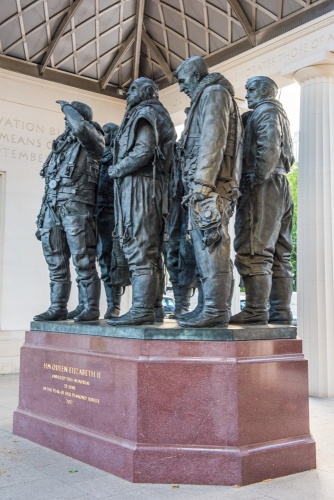
Immediately beside the Bomber Command Memorial is the Queen's Meadow, a one-acre patch of meadow created in 2016 in honour of Elizabeth I's 90th birthday and as part of HRH the Prince of Wales' campaign to plant a new meadow in every British county. It was the 90th meadow created as part of the scheme and was sewn with seeds from two ancient meadows; Horsenden Meadow in Ealing, and Valebridge Common in West Sussex.
Canada Gate
This ornate set of iron gates faces Buckingham Palace and acts as the official entrance to Green Park. The gates were given by Canada in the early 20th century in honour of Queen Victoria. The ornate ironwork includes the crests of all the Canadian provinces.
The Canada Gate gives access to the Broadwalk, a wide tree-lined avenue planted in 1905 to give a view of the Victoria Memorial from Piccadilly to the north. The Broadwalk follows the course of the River Tyburn, which now flows underground to the River Thames.
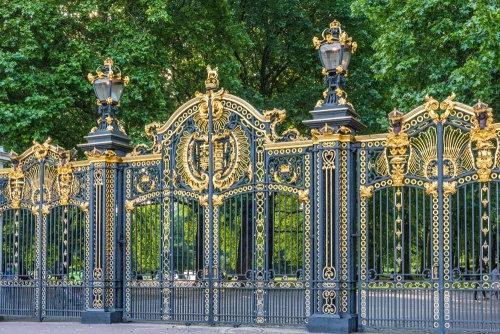
Canada Memorial
From Canada Gate it is just a stone's throw to another Canadian contribution to the park's landscape, the Canada Memorial, installed in 1994 to honour the 1 million Canadians who served with the British military in WWI and WWII. The memorial was designed by the French-Canadian artist Pierre Granche.
The memorial is divided into two parts by a narrow walkway which is aligned towards the port of Halifax (in Novia Scotia, not the town in Yorkshire) where many Canadian service personnel embarked for Europe. The sloping monument is made of granite, with bronze maple leaf symbols embedded in the surface. The maple leaf is Canada's official symbol and appears on the Canadian flag.
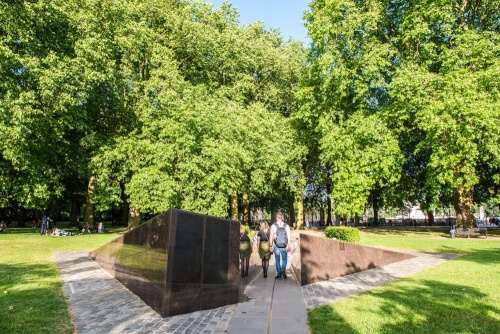
Memorial Gates
Near the top end of Constitution Hill is a set of memorial gates commemorating the role of people from the Indian sub-continent, Africa and the Caribbean who served in the two World Wars. They also honour the contributions made by people from these areas to life in Britain over the centuries.
The pillars are made of Portland stone and topped with ceremonial bronze urns. These urns are made to hold a gas flame which is lit on special occasions such as Armistice Day, Remembrance Sunday, and Commonwealth Day.
The pillars are carved with the names India, Pakistan, Bangladesh, Sri Lanka, Africa, the Caribbean, and the Kingdom of Nepal.
Just inside the Memorial Gates is a small domed pavilion. The interior of the dome is carved with the names of Victoria and George Cross recipients from these countries.
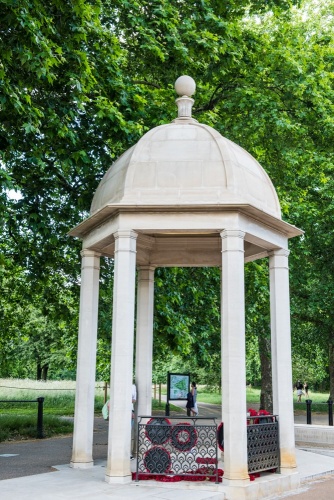
The Diana Fountain
Just inside the north-east corner of the park is a striking water fountain by Jim Clack, dubbed 'Diana of the Treetops'. The statue owes its existence to the artist Sigismund Goetze, who left money in his will to provide sculptures for all of London's parks. A design competition was held and the winner was Clack, a schoolteacher from Devon.
The statue was erected in the centre of the park to replace an earlier fountain that had fallen into disrepair. In 2011 it was moved to its present location to be the centrepiece for a new entrance to the park from Green Park underground station.
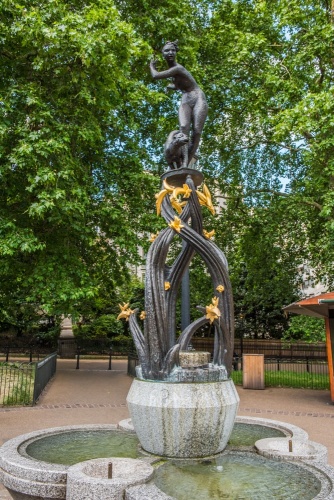
Two memorable buildings stand immediately outside the park. One is the world-famous Ritz Hotel on Piccadilly. The other is Spencer House, the London home of the Spencer family of Althorp in Northamptonshire, whose most famous member was Diana, Princess of Wales. You can see the rear facade of Spencer House from the path that runs down the eastern edge of Green Park.
Getting There
There is no public parking facility in Green Park. By far the easiest way to reach the park is by underground to Green Park station (Jubilee, Piccadilly and Victoria lines). From the station exit simply turn left, following the signs from Green Park and Buckingham Palace.
The park office is in St James Park.
About Green Park
Address: Piccadilly,
London,
Greater London,
England
Attraction Type: Countryside - Royal Park
Location: Directly north of Buckingham Palace. Easy access from Green Park underground station.
Website: Green Park
Royal Parks
Location map
OS: TQ289799
Photo Credit: David Ross and Britain Express
Nearest station: ![]() Green Park - 0.2 miles (straight line) - Zone: 1
Green Park - 0.2 miles (straight line) - Zone: 1
HERITAGE
 We've 'tagged' this attraction information to help you find related historic attractions and learn more about major time periods mentioned.
We've 'tagged' this attraction information to help you find related historic attractions and learn more about major time periods mentioned.
Find other attractions tagged with:
NEARBY HISTORIC ATTRACTIONS
Heritage Rated from 1- 5 (low to exceptional) on historic interest
Clarence House - 0.2 miles (Historic Building) ![]()
St James Palace - 0.2 miles (Historic Building) ![]()
Texas Legation - 0.2 miles (Landmark) ![]()
Queen's Gallery - 0.3 miles (Museum) ![]()
Spencer House - 0.3 miles (Historic Building) ![]()
Wellington Arch - 0.3 miles (Historic Building) ![]()
Burlington Arcade - 0.3 miles (Landmark) ![]()
Royal Mews - 0.4 miles (Museum) ![]()
Nearest Holiday Cottages to Green Park:
Leaves Green, Greater London
Sleeps: 6
Stay from: £871 - 3127
More self catering near Green Park
